Who hasn't stood and marvelled at Redwings tseeping overhead on a dank October night? Or waited for early-morning news of a rarity in case it had departed overnight? Despite this, how many of us have given nocturnal bird migration much further thought? I confess I hadn't appreciated its breadth and scale until March 2017, when I recorded the night flight call of a Common Moorhen – a first for my suburban garden. As a keen birder I've always been fascinated by bird migration; always eager to get to the coast to see it in full flow. But noc-mig has opened my eyes – and ears – to what is going on overhead while I sleep.
Recording the flight calls of night-flying birds is not particularly new, but interest has increased among European birders, whether to boost garden lists (however defined …) or to collect valuable data on nocturnal migration to complement daytime data gathered through platforms like BirdTrack. Yet, for the uninitiated, talk of spectrograms, sample rates, phantom power and the baffling array of audio kit available can make 'noc-mig' sound daunting. This is the first in a mini-series of articles aiming to demystify noc-mig for birders thinking of giving it a try.
The basics
Fundamentally, noc-mig recording involves leaving an audio device running continuously to record a full night's worth of sounds. In October, that means 12 or more hours of audio – impractical to listen to in full! The key that makes noc-mig feasible is that long digital sound files can be transferred to a computer where they can be viewed as a spectrogram. A spectrogram is a way of visualising how sound frequencies vary through time and is probably the most important concept to grasp.
As different bird species – and indeed all ambient sounds – have distinctive signatures on a spectrogram, you can scroll through the pages of said spectrogram, skipping past barking dogs and other noises until you see a bird call. To paraphrase Cypher from The Matrix: “You get used to it, though ... I don't even see the spectrogram. All I see is Blackbird, Redwing …”. Armed with a spectrogram, you can quickly process hours of audio to find and identify calls of interest.
At present there isn't a reliable automated shortcut to processing these long files (several of us are working on this). In any case, this is where much of the fun and challenge comes in, not knowing what species might be on the next file and wondering just how do you identify an invisible Pied Flycatcher. More on spectrograms later ...
Equipment
Sound recording is like photography – you can get surprisingly good results of close subjects with a smartphone, or you can spend a fortune on dedicated kit that will extend the range and increase the quality of your recordings. For anyone seriously considering sound recording in a range of settings, there is excellent advice provided by the Wildlife Sound Recording Society here.
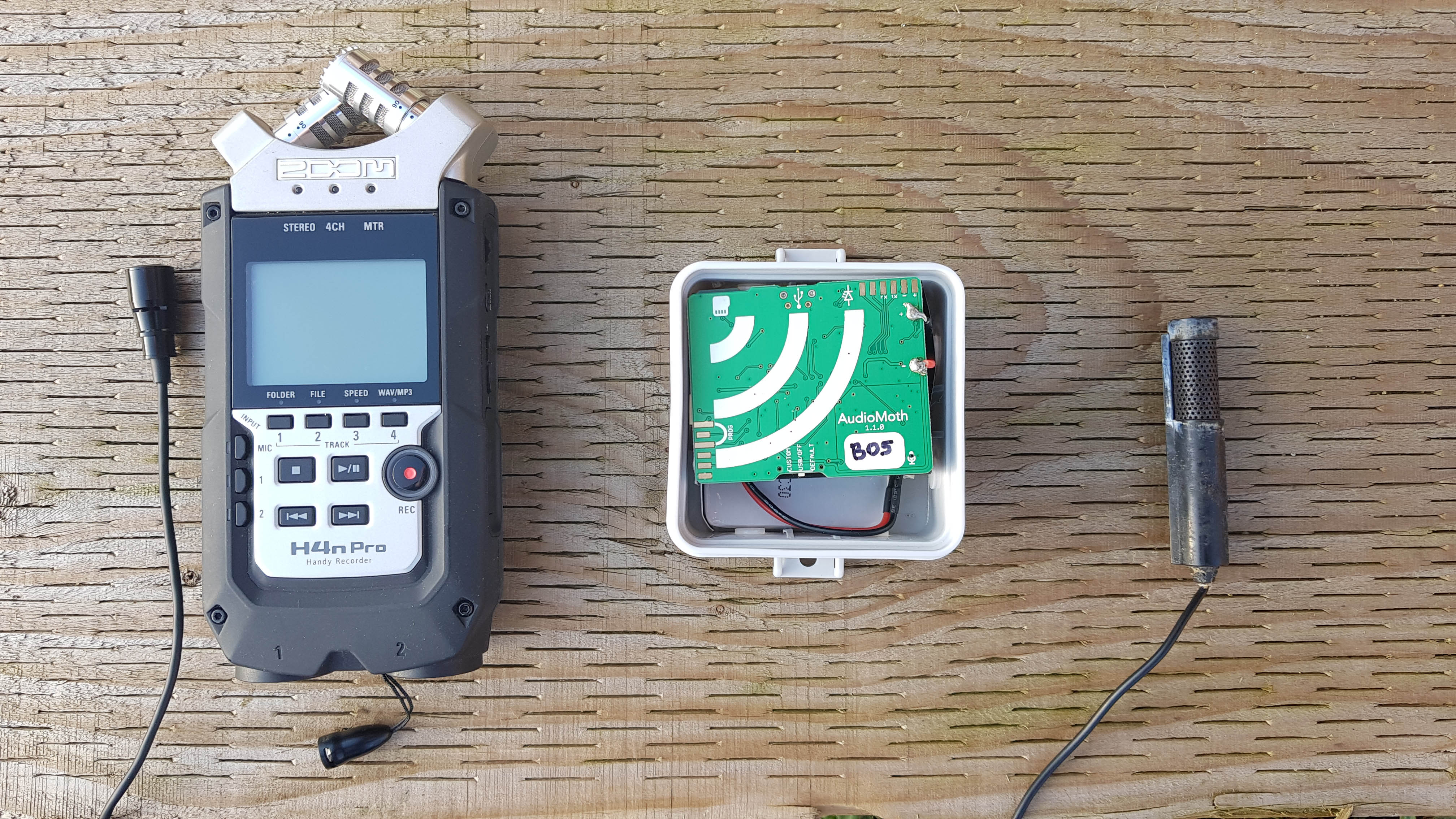
A sound recorder (left) is a popular equipment choice for noc-mig, though a programmable device such as an Audiomoth (middle) or a simple USB mini microphone (right) plugged into a computer offer alternative options at different ends of the budget and quality scales (Simon Gillings).
For noc-mig, there are several potential equipment permutations, so to simplify I have described three differing options below. For each setup I've included a sound clip of a call made with that equipment. The gear that's appropriate for you will depend on factors such as budget, what you already have, and whether you want to use the kit for other purposes.
Equipment option one: testing the water
If you're on a tight budget and already have a computer, for roughly £20 you can use a USB mini microphone of the style used for video conferencing (see here). Connect it to your computer, put the mic out of the window and either listen live or use a package like Audacity or Raven Lite to record the sounds. You won't get the best range or quality with this method, but it's a good starting point for checking if anything is moving over your location and whether noc-mig is your thing.
Nocturnal flight call of a Eurasian Coot, recorded using a cheap USB microphone and desktop PC in Cambridge, England, at 23:49 on 4 April 2017 [note: turn your volume up, as it is quiet!] (Simon Gillings).
Equipment option two: taking the plunge
Most noc-mig recordists use a portable digital audio recorder. These have inbuilt microphones so the recorder can be left out all night (see here). However, these recorders are not waterproof, and as the best nights for noc-mig are when it's dull and damp, a better/safer option is to keep the recorder dry inside and to connect a microphone that you can place outside. This setup has the benefits of using mains power for the recorder and the potential to listen in real time to what you're recording – so you can dash outside when that Ortolan Bunting flies over!
So which recorder? There are many different options and a wide price range to match. Recorders in the £100-200 bracket that are popular with 'noc-miggers' include the Zoom H4n Pro, Olympus LS12 and Tascam DR-40, but new models are always appearing. Key considerations when getting a recorder include:
- Does it accept an external microphone, and if so via which type of sockets? There are two main types, the familiar 3.5 mm TRS connection or 3-pin XLR connection. For noc-mig purposes, either is fine, but a recorder that has both will be more versatile in the long term if you might upgrade to a mic that requires different cabling/powering.
- How good is the sound quality? The electronics that convert the sound input to digital files can cause unwanted noise (hiss) in the recording. Look for 'low self noise' or 'quiet pre-amps' in reviews.
- Does it accept mains power? A battery-powered recorder may not last the whole night, so you may want an AC adapter. If recording away from home you might need the option to plug in an external rechargeable battery pack.
- Can you record in WAV format? Digital audio is often saved as either MP3 or WAV files. MP3 files are equivalent to JPEG photo files, having been compressed to make them smaller. This compression can introduce some artefacts, but for casual recording, MP3s are fine. For greater versatility you might want the option to save uncompressed WAV files for future editing.
- Does it take a memory card? 12 hours of mono recording will total some 1GB of MP3 files, or at least 4GB of WAV files, so you'll probably need extra storage.
Now to microphones. If you want to keep your recorder dry, one option is to use a good quality lapel (also called lavalier) microphone. These small mics (see here) can give surprisingly good results but, as they are not directional, they will pick up all other surrounding sounds too.
Nocturnal flight call of a Eurasian Bittern, recorded using lapel microphone and a portable audio recorder in Eilat, Israel, at 01:32 on 31 March 2019 (Simon Gillings).
Most noc-mig recordists use either a shotgun microphone (see here) or a parabolic microphone (see here). Shotgun mics are designed to limit sound pickup from the sides to help isolate the sound of interest, but they do not increase the volume of a sound. In contrast, the reflective dish of a parabolic mic makes it both directional and sound enhancing (also called gain).
Both methods have their merits and drawbacks. For example, shotgun mics are more portable for taking in the field or when travelling, but they suffer from wind noise so a windshield is essential. Shotgun mics can be bought for as little as £25 but better quality mics like the Rode NTG1 and Sennheiser ME66 are in the range £160–250.
Nocturnal flight calls of Song Thrush, Redwing and Blackbird, recorded using a shotgun microphone and an Olympus LS-12 portable audio recorder in Cambridge, England, at 23:50 on 29 October 2019 (Jon Heath).
Personally, for detecting night flight calls, which often can be quite quiet, I prefer the parabolic mic for the extra volume it gives. Unfortunately, unless you're interested in DIY options, there are few manufacturers of parabolic mics (Dodotronic, Telinga, Wildtronics) and prices quickly exceed £500.
Nocturnal flight call of a Little Grebe, recorded using a Dodotronic parabolic microphone and Sound Devices audio recorder, in Cambridge, England, at 00:18 on 6 May 2019 (Simon Gillings).
Equipment option three: going 'hands free'
All the options listed above require you to turn on in the evening and off in the morning, which is fine for the garden, but if you want to record elsewhere you'll want something programmable. There are several commercially available devices for remote surveying of bats, birds and other wildlife: the AudioMoth, Wildlife Acoustics SM4 and Cornell Swift can be customised to run on whatever recording schedule you wish. They vary in price, from c£80 for an AudioMoth to c£800 for an SM4 and with that comes an associated variation in recording quality.
For its price and size, the Audiomoth is a tempting option but difficulties with waterproofing and slightly inferior recording quality mean a portable digital audio recorder is probably a better investment unless programmability is a must-have.
Nocturnal flight calls of a pair of Eurasian Teal, recorded using an AudioMoth in Skagen, Denmark, at 22:04 on 8 May 2018 (Simon Gillings).
Equipment disclaimer: I have used some of the equipment listed above, and have gleaned information on others from fellow sound recordists. Other brands and models exist than those listed. Some comparisons of the same calls recorded using different equipment can be seen here.
Spectrograms
Reading spectrograms is fundamental to noc-mig, and has wider applications for understanding some identification challenges like Common Chiffchaffs and Lesser Whitethroats. On a spectrogram, time is represented on the horizontal axis and sound frequency is represented on the vertical axis. You may see spectrograms in shades of grey or a range of other colour scales (e.g. Audacity's default blue-pink). Depending on the colour scale used, brighter or darker colours indicate the pattern of sound frequencies that are loudest through the recording.
A low-frequency sound, like a Eurasian Bittern boom, would appear low down relative to this axis, whereas a high-frequency sounds such as a Goldcrest call would appear high up. Call shapes denote characteristics of a call. For example, clear notes like a Reed Bunting tseew call are thin and sharply defined, whereas buzzy notes like a Redwing tseep call are wider and sometimes fuzzier.
Below are spectrograms for the five sound clips from earlier. All have the same vertical range (0 to 10kHz) but, like the sound clips, they vary in length. Here, darker blues indicate stronger/louder sounds.
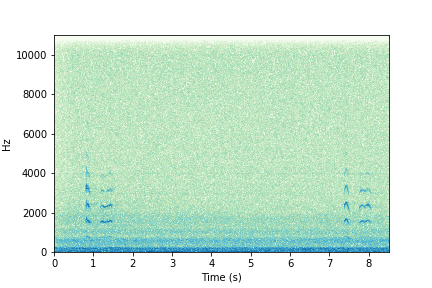
Night flight calls of a Eurasian Coot (sound clip one). Coot calls can consist of multiple parts and are given in short bursts several seconds apart. They are usually layered, with sounds at different frequencies (i.e.the different vertical bands), giving a multi-tonal quality.
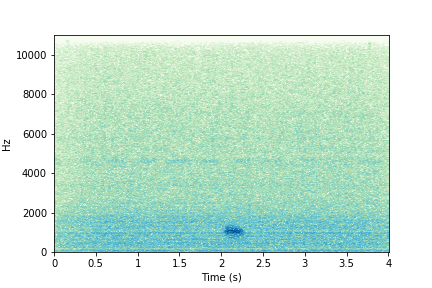
Night flight call of a Eurasian Bittern (sound clip two). The short 'graow' call is low down, at around 1 kHz and slightly arched. Read more about Eurasian Bittern calls here.
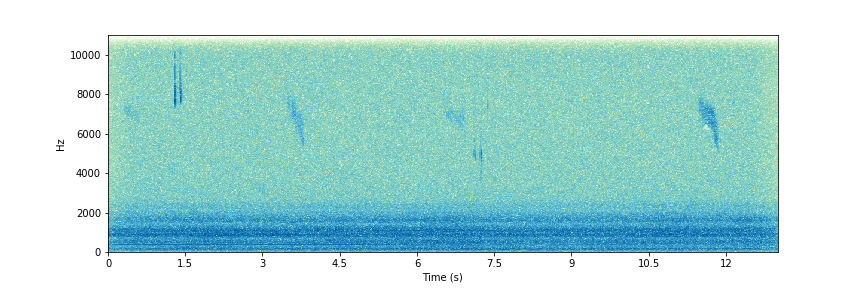
This longer clip contains flight calls thrushes (sound clip three) including calls of Redwing at 1, 4 and 12 seconds, a double call of a Song Thrush at 1.5 seconds and a Blackbird at 7 seconds. Note how these high-frequency calls are towards the top of the spectrogram, and the distinctive down-slurred Redwing call has a corresponding downward smeared shape. This clip also has a lot of dark shading at the bottom, indicative of loud low frequency sounds from distant roads.
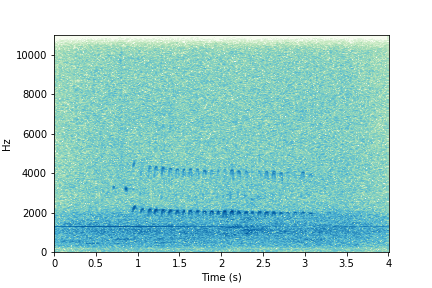
The nighttime flight trill of a Little Grebe (sound clip four) with the string of closely spaced notes, slightly descending in frequency. Whimbrel calls are similar but usually not so long and they lack the couple of "pips" at the start.
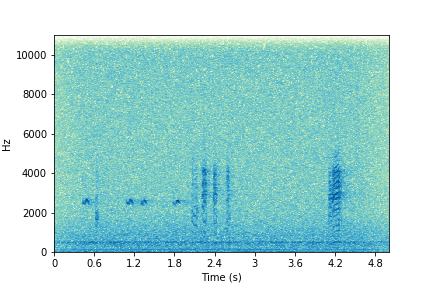
Nighttime flight calls of a pair of Eurasian Teal (centre part of sound clip five), with the discrete notes of four male whistles followed the broadband quacks of a female.
For more general information on reading spectrograms, see the excellent introduction in The Sound Approach to Birding. When first starting out, the best software to use to display recordings as a spectrogram is Audacity (see here). This can be downloaded and installed for free on PC and Mac. You can read more about how to use Audacity here.
Identifying calls
Armed with the knowledge of how to create a spectrogram you'll be able to scan through your night-long recordings to find bird calls. Most species use the same calls at night as during daytime flight so are readily identifiable. Nevertheless there are some surprising similarities to trap the unwary. For example, distant Tawny Owl, Eurasian Oystercatcher and Eurasian Wigeon – species we would never confuse by day – look and sound surprisingly alike.
Anyone who has been noc-mig recording for a while will have a folder of 'unknowns' containing unidentified squeaks, chips and whistles. Do not be put off if many of your sounds gravitate to the unknown folder. With experience some of these will become resolved – as Joost van Bruggen, an experienced noc-mig recorder from The Netherlands says, if in doubt, it's probably a Eurasian Coot! But other sounds will probably forever remain as ones that got away.
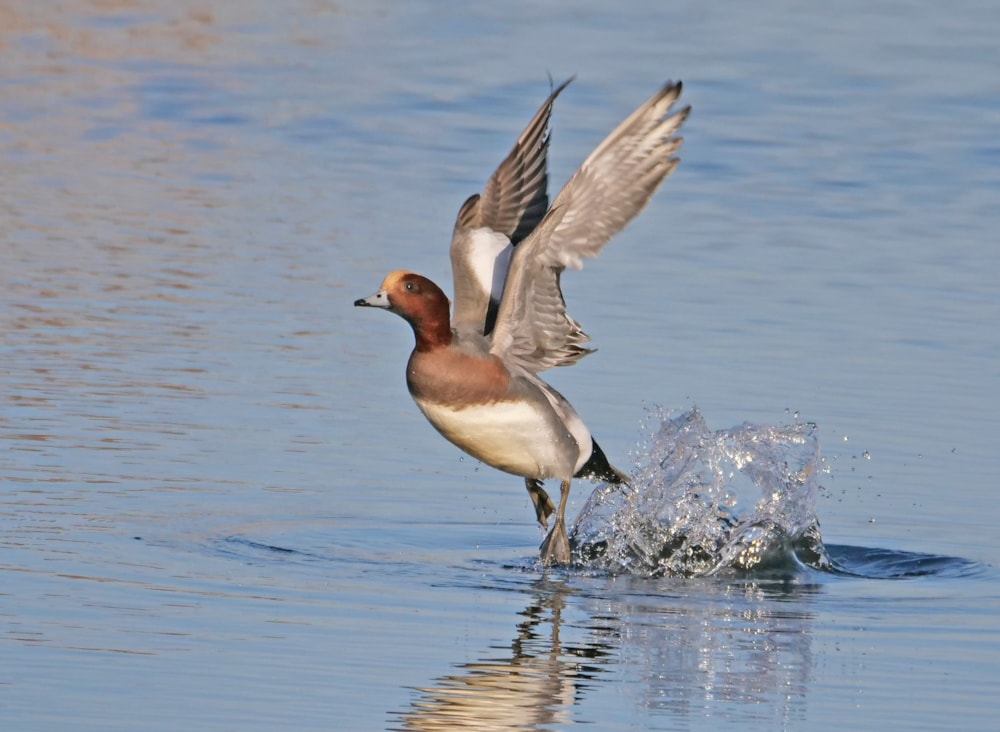
It's surprising how similar the calls of Eurasian Wigeon can look to species such as Eurasian Oystercatcher and Tawny Owl on a spectrogram, despite not actually looking anything like each other when seen (Paul Bateson).
While it is true that anything can fly over your noc-mig microphone, the majority of sounds will come from common and widespread birds, so it pays to be cautious. When presented with a tricky call, you can download sample recordings from Xeno-Canto. These can be cut and pasted in Audacity alongside your mystery call for side-by-side comparison. If in doubt, create an account with Xeno-Canto and upload your clip as a mystery recording to get input from this very helpful online community. There are also great resources available from The Sound Approach team, on the birds-in-flight website and on the nocmig website.
Hopefully this article has given you a taster of what you could record with different recording gear. In future articles we will cover some of the species that are commonly recorded via noc-mig, how to extract and share useful data, urban noc-mig and more. Stay tuned!

